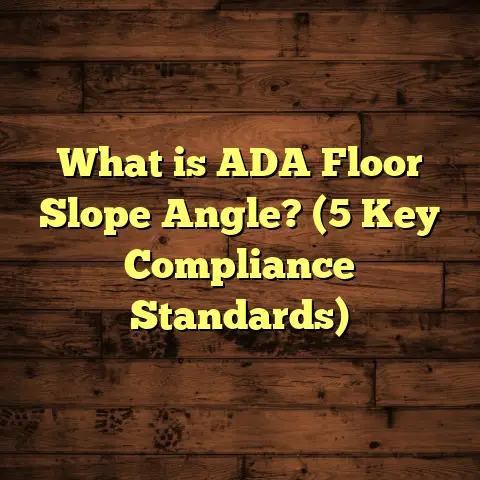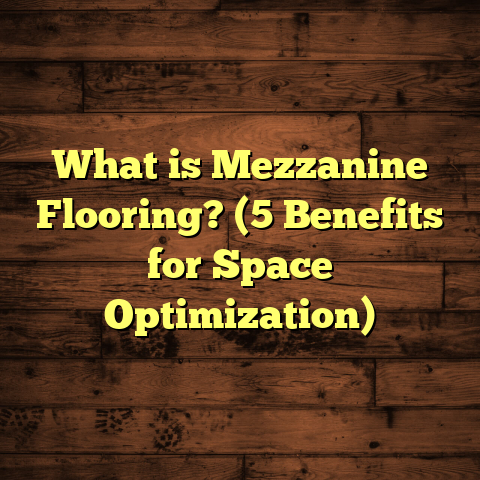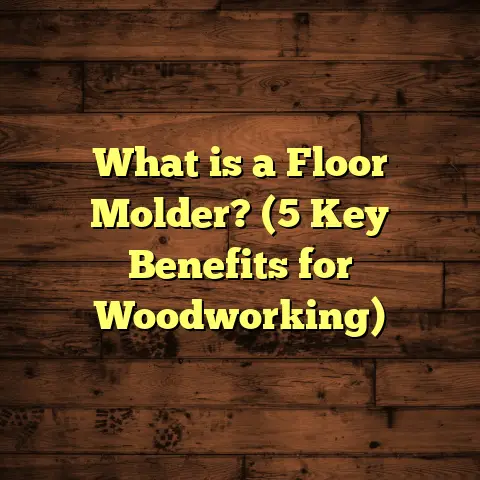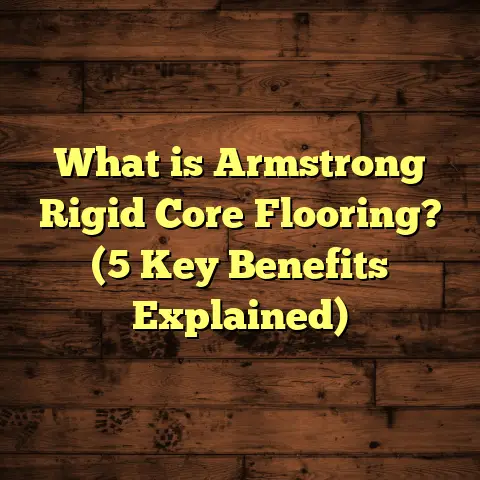What is Cheaper: Vinyl Flooring or Carpet? (5 Key Cost Factors Revealed)
Have you ever stood in a flooring store, staring at endless rolls of carpet and sleek vinyl planks, wondering which one will cost you less without sacrificing style or durability? I’ve been there more times than I can count. Deciding between vinyl flooring and carpet isn’t just about picking what looks good; it’s a financial puzzle with many pieces. After working as a flooring contractor for years and helping countless homeowners make these decisions, I’ve gathered some real insights on the true costs behind these two popular options.
What Is Vinyl Flooring and Carpet?
Let’s start with the basics. Vinyl flooring is a synthetic material made primarily from polyvinyl chloride (PVC). It comes in sheets, tiles, or planks, often designed to mimic natural materials like wood or stone. Vinyl is known for being durable, water-resistant, and low-maintenance.
Carpet, on the other hand, is a textile floor covering made from fibers like nylon, polyester, or wool, attached to a backing material. It comes in various styles—from plush and soft to looped and durable—and adds warmth and comfort to any room.
Now that we know what they are, let’s chat about how their costs stack up—not just at purchase but over time.
1. Upfront Material Costs: How Much Do You Pay Right Away?
When you’re budgeting for new flooring, the price per square foot of materials is the first thing that hits you. I remember when I first started advising clients on flooring options; many of them underestimated how much the material cost alone would impact their entire budget.
Vinyl Flooring Costs
Vinyl flooring prices vary depending on the type you choose:
- Sheet Vinyl: Cheapest option, usually $0.50 to $2 per square foot.
- Vinyl Tiles: Priced around $1 to $4 per square foot.
- Luxury Vinyl Plank (LVP): High-quality vinyl resembling hardwood costs between $3 and $5 per square foot.
A client of mine once wanted to install vinyl tile in a kitchen remodel. The tiles were priced at $2.50 per square foot, which seemed affordable until we factored in the extra adhesive and underlayment needed for a smooth finish.
Carpet Costs
Carpet pricing depends largely on fiber type and quality:
- Nylon Carpets: Most popular and durable, ranging from $2 to $5 per square foot.
- Polyester Carpets: Cheaper but less durable, around $1.50 to $3 per square foot.
- Wool Carpets: Premium option, costing $6 or more per square foot.
Don’t forget padding! Carpet requires padding underneath for comfort and longevity, which can add $0.50 to $1 per square foot.
Personal Story: I once worked with a family who loved the look of soft wool carpet in their living room. The material alone was about $7/sq ft with premium padding adding another dollar per square foot. That upfront cost surprised them but they considered it an investment in luxury.
Comparing Material Costs
To give you a clearer picture:
| Flooring Type | Material Cost Range (per sq ft) | Padding Cost (per sq ft) | Notes |
|---|---|---|---|
| Sheet Vinyl | $0.50 – $2 | N/A | Cheapest vinyl option |
| Vinyl Tiles | $1 – $4 | N/A | Requires adhesive |
| Luxury Vinyl Plank | $3 – $5 | Optional underlayment | Mimics hardwood |
| Nylon Carpet | $2 – $5 | $0.50 – $1 | Durable, popular |
| Polyester Carpet | $1.50 – $3 | $0.50 – $1 | Less durable |
| Wool Carpet | $6+ | $0.75 – $1 | Premium natural fiber |
2. Installation Expenses: What Does It Take to Get These Floors In?
Installation costs can shape your overall budget significantly. Let me share some of my experiences here because installation is often where surprises happen.
Vinyl Installation
Vinyl flooring installation depends on type and method:
- Sheet Vinyl: Needs careful cutting and fitting; installation typically costs between $1 and $3 per square foot.
- Vinyl Planks/Tiles: Click-lock planks can be easier to install and might cost less if DIY is an option; professional install tends to be $1.50 to $3 per square foot.
Vinyl requires a smooth subfloor to prevent imperfections from showing through. If your subfloor isn’t flat, expect additional prep costs.
Carpet Installation
Carpet installation includes several steps: laying padding, stretching the carpet to avoid wrinkles, trimming excess material, and tacking it down.
Carpet installation generally costs between $1 and $2 per square foot but can go higher if stairs or complicated layouts are involved.
I remember installing carpet for a client who had a uniquely shaped room with many corners. The installer charged extra for the complexity—it added about 25% more labor cost than a regular rectangular space.
DIY vs Professional Installation
One advantage vinyl often has is the option for DIY installation thanks to click-lock designs on many planks and tiles. This can save you hundreds or even thousands in labor if you’re comfortable with tools.
Carpet installation is trickier for most homeowners because it requires stretchers and professional-grade tools.
3. Longevity and Replacement Frequency: How Long Will Your Floor Last?
Choosing cheaper flooring upfront might backfire if you end up replacing it sooner than expected.
Vinyl Longevity
Good-quality vinyl can last 10-20 years or more with proper care. It’s resistant to moisture and scratches, which makes it ideal for kitchens, basements, and bathrooms.
I once encountered a commercial property that installed vinyl flooring 18 years ago—still holding up well despite heavy foot traffic.
Carpet Longevity
Carpet typically lasts 5-15 years depending on fiber quality, traffic levels, and maintenance.
High-traffic areas tend to wear carpets out faster due to matting and staining.
One of my clients with young kids found their mid-grade nylon carpet was worn through in just 6 years in their living room—prompting an early replacement.
Replacement Cost Impact
Keep in mind that replacement costs add up over time:
- Replacing carpet every 7-10 years adds more expense than installing vinyl once every 15-20 years.
- Vinyl’s durability can make it more cost-effective long-term despite slightly higher initial costs.
4. Maintenance Costs: What Are You Paying to Keep It Looking Good?
Maintenance is often overlooked but can become a significant expense.
Maintaining Vinyl Flooring
Vinyl floors require sweeping or vacuuming regularly and occasional mopping with mild detergent.
No special cleaners are needed, and vinyl doesn’t trap dust or allergens like carpet does.
I’ve advised numerous allergy-prone clients to choose vinyl for this reason—it lowers cleaning time and improves indoor air quality.
Maintaining Carpet
Carpet requires frequent vacuuming—especially if you have pets or kids—and occasional professional cleaning.
Professional steam cleaning costs can range from $100 to $300 depending on room size.
Stain treatments also add up over time if spills happen often.
Real Numbers on Maintenance
Let me share data from my own projects:
- Average annual cost for vinyl maintenance: around $20-$40 (cleaning supplies).
- Average annual cost for carpet maintenance including professional cleaning every 12-18 months: approximately $150-$250.
Over a decade, this difference becomes substantial.
5. Additional Cost Factors That Can Tip the Scale
There are other financial factors that don’t always get talked about but matter:
Waste Factor
- Vinyl typically has about 5% waste because planks and tiles fit together efficiently.
- Carpet waste can reach up to 10% due to pattern matching and trimming excess material during installation.
This means you’ll need to buy slightly more carpet than your room’s exact size, increasing material costs.
Subfloor Preparation
Vinyl needs a flat subfloor free of bumps or debris; sometimes this means adding leveling compound—a costly step depending on the condition of your floor beneath.
Carpet tolerates minor unevenness better but still requires a solid base.
Removal of Old Flooring
Removing existing floors adds labor and disposal fees:
- Carpet removal tends to be easier but disposal fees vary by location.
- Vinyl removal can be trickier if glued down firmly; expect higher labor costs here.
How I Helped a Family Choose Between Vinyl and Carpet: A Case Study
A couple from Atlanta wanted new flooring in their basement renovation. They loved the softness of carpet but worried about basement moisture damaging it over time.
We compared total costs over 10 years including:
- Initial purchase and installation
- Maintenance (cleaning supplies vs professional carpet cleaning)
- Replacement cycles (vinyl lasting twice as long)
- Moisture damage risk (carpet prone to mold)
The numbers showed:
| Cost Factor | Vinyl Flooring Total | Carpet Total |
|---|---|---|
| Initial Material + Install | $3,500 | $3,200 |
| Maintenance (10 years) | $300 | $1,500 |
| Replacement (once vs twice) | $0 | $1,200 |
| Moisture Damage Risk Cost | Low | High |
| Total Estimated Cost | $3,800 | $5,900 |
They chose vinyl because it saved nearly $2,000 over ten years plus avoided moisture problems common in their area.
Other Personal Stories That Might Help
The Pet Owner’s Dilemma
A client with three dogs wanted an affordable floor that could handle accidents without smelling or staining permanently.
We went with luxury vinyl plank that looked like hardwood but was waterproof and easy to clean.
Carpet was quickly ruled out due to stain risk despite lower upfront cost.
Years later, he tells me he’s glad he invested more initially because his floors still look great while friends with carpet struggled with odors and stains after just a few years.
The Cozy Homeowner
On the flip side, a client who loves cozy interiors opted for high-end wool carpet in her bedroom despite the cost because she loves the softness underfoot during winter mornings. She budgeted extra for professional cleaning twice a year.
She acknowledges higher maintenance but values comfort over cost savings here — which is perfectly fine!
What About Environmental Impact? Does That Affect Cost?
More homeowners ask me about eco-friendliness nowadays. While not direct cost factors, environmental considerations can influence your choice—and potentially future resale value.
- Vinyl: Made mostly from PVC plastic; not biodegradable but many brands now offer recyclable options.
- Carpet: Natural fibers like wool are renewable but synthetic fibers come from petroleum products and may off-gas VOCs initially.
If you want green options:
- Look for carpets with recycled content or those certified by eco-labels.
- Choose vinyl products labeled as phthalate-free or made with recycled materials.
Sometimes eco-friendly products cost more upfront but might qualify for rebates or tax credits depending on your location—something worth checking out when budgeting.
Breaking Down Cost Per Room Type
Let’s look at typical rooms where you might install carpet or vinyl and how costs differ:
| Room Type | Preferred Flooring Type(s) | Cost Considerations |
|---|---|---|
| Living Room | Carpet or Luxury Vinyl Plank | Comfort vs durability; mid-high budgets |
| Kitchen | Sheet Vinyl or Luxury Vinyl Plank | Water resistance critical; carpet not ideal |
| Bedroom | Carpet preferred for warmth | Softer feel valued; maintenance easier |
| Basement | Waterproof vinyl | Moisture issues make carpet risky |
| Bathroom | Sheet vinyl or tile | High moisture requires waterproof flooring |
Pricing Trends Over Time: Has One Gotten Cheaper?
From my experience tracking market prices over past decade:
- Vinyl prices have dropped slightly due to manufacturing improvements.
- Carpet prices have been steady or slightly increased because of rising raw material costs.
This trend makes vinyl comparatively more attractive financially than it was years ago.
Final Thoughts
Choosing cheaper flooring isn’t always straightforward since upfront price is just one piece of the puzzle. Vinyl flooring often edges out carpet on long-term value thanks to durability and easier upkeep. But if softness underfoot or a cozy vibe is your priority, carpet might still be your pick—and you can budget accordingly for its maintenance.
What kind of space are you thinking about? High traffic? Kids or pets? These details matter a lot when weighing costs beyond just dollars per square foot.
Feel free to ask me any questions about your specific project—I’m happy to share what I’ve learned from years working hands-on with both materials!
If you want me to help crunch numbers for your particular home size or give personalized advice based on your needs, just say the word!





